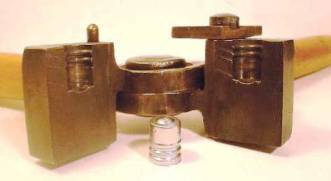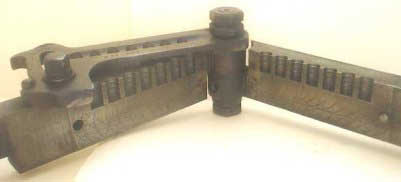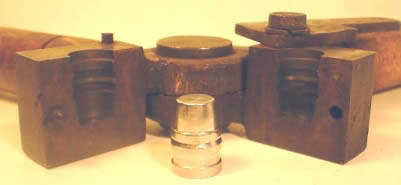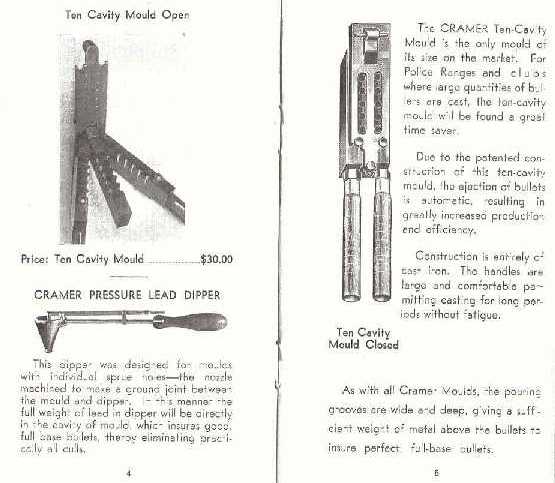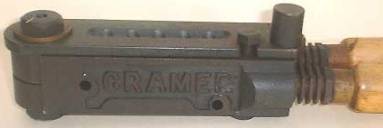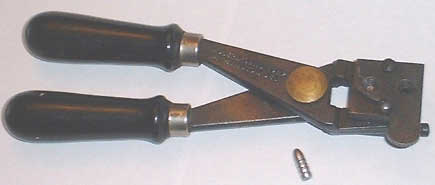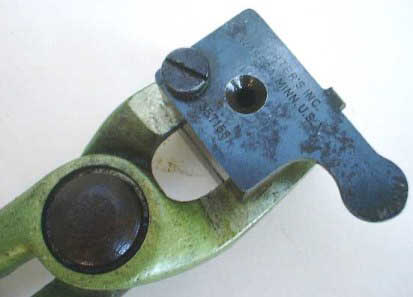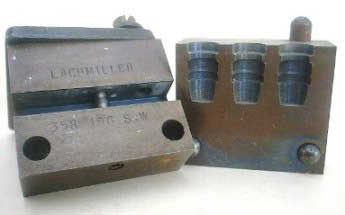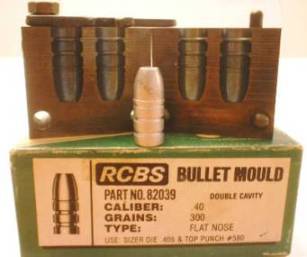|
|
||||||||||||||||||||||||||||||||
|
Chapter One |
||||||||||||||||||||||||||||||||
|
Introduction: A Brief History of Bullet Casting |
||||||||||||||||||||||||||||||||
|
Bullet casting contributed significantly to the independence of the western cowboy, trapper and mountain man. That independence is still valuable today. Just like the mountain man, once the modern caster buys a particular mould he can produce that bullet for the rest of his life, and he doesn’t have to worry about whether commercial bullet makers will alter or drop a particular favorite from their line. The ability to produce countless thousands of identical bullets for decades to come reveals what a miniscule investment a bullet mould really is. History Originally bullet moulds were made and sold by the firearms manufacturers themselves. Colt was an early player in the mould manufacturing game, making ball and conical bullet moulds for their early cap-n-ball revolvers. Shortly after the advent of the self-contained centerfire (i.e. reloadable) cartridge more sophisticated reloading tools became available. Soon after S&W graduated from rimfire cartridges to their centerfire Number 3 .44 American in 1870, they also added loading tools, including bullet moulds, to their product line. In the Remington catalogs of the 1870s are listed bullet moulds made by the Bridgeport Gun Implement Co. (BGI was a partner company, started around 1870 specifically to make loading tools for Remington). Winchester started making iron-handled bullet moulds in 1875 (and in a humanitarian gesture added wooden handles in 1890). In their 1876 catalog, Sharps advertised bullet moulds to make paper-patched bullets for their popular and powerful rifles. Marlin (Ballard) was also making moulds in the 1870s, and in 1881 enlisted none other than John M. Browning’s input for a mould/loading tool that he designed and patented, and was subsequently manufactured by Marlin. The Maynard 1873 cartridge had a 5-piece case, very thick cartridge head and Berdan primer. The Maynard loading tools had a bullet mould, as well as a hook and a chisel for prying the spent primers out of the spent cartridge case. One of the more unique moulds from this era is that for the Maynard exploding bullet, a HP designed to be fitted with a .22 blank cartridge, advertised in the 1885 Maynard catalog in .40, .44 and .50 caliber. The 1870s were indeed a time of great change in the firearms industry. In 1884 John H. Barlow took his experience as a shooter and as a tool and die maker and founded the Ideal Company, offering his patented tong tools to reload spent cases, and later separate bullet moulds for those using bench-mounted presses. These bullet moulds were either single cavity, or 6- or 7-cavity Armory moulds, all with fixed handles at this point.
The landscape was changing dramatically in the firearms industry in the late 1800’s and early 1900’s, and John Barlow kept pace with his contributions. His Ideal Handbooks (first published in the 1880's) were the first reloading guides published in America, of critical importance as shooters moved into the relatively uncharted territory of the then new smokeless powders. In Ideal Handbook #4 (published in 1890), he described the use of cast hollow-pointed bullets for enhanced performance on game animals. In Ideal Handbook #9 (1897) he unveiled the now familiar mould numbering scheme for Ideal's first 150 mould designs. In 1906, Barlow patented the first American gas-checked cast bullet designs to take advantage of the higher velocities available from the new smokeless powders (described later that year in Ideal Handbook #17). In May of 1910, after leading the Ideal Manufacturing Co. for 26 years, Mr. Barlow retired and sold the company to The Marlin Firearms Co., with whom he had worked closely for many years. Marlin sold Ideal a few years later during the first World War to Phineas Talcott (but Marlin remained involved with production of the Ideal Handbook). By 1925 things were not going well and Phineas Talcott sold the struggling Ideal Reloading Tool Company to the Lyman Gun Sight Corporation (founded by William Lyman in 1878), along with the rights to the Ideal Handbook (which was later renamed “The Lyman Handbook“ with #27, published in 1926). Lyman scaled up manufacturing capacity and continued production of the Ideal line of bullets moulds, using the Ideal name into the late 1950s. During this time Lyman introduced interchangeable mould blocks in their single cavity moulds (first advertised in the American Rifleman in 1927, and cataloged in 1931), and phased out the older fixed handle style. In 1940-1 (Ideal Handbook #34), Lyman added a special retaining pin to hold their hollow point plug in place during casting. Interchangeable double cavity mould blocks didn’t appear until after World War II (first listed in the Ideal Handbook #36, which was published in 1949), followed soon thereafter by venting lines cut in the faces of the mould blocks. Interchangeable 4-cavity mould blocks were introduced in 1958. Lyman continues to produce many of these mould designs to this day.
Early Ideal rifle bullets were designed not only by John Barlow, but also by such notable shooters as Harry Pope, Col. Townsend Whelen, and Phil Sharpe, among others. In the early 1920s, a vociferous northwestern cowboy, rancher and competitive shooter named Elmer Keith went to Belding & Mull with some of his ideas for experimental revolver bullets. Belding & Mull made the moulds (interestingly, B&M moulds were made out of solid nickel) and Keith assembled and evaluated many test loads using these bullets. Keith learned much from these experiments with cast bullet design, but he never quite got to where he wanted to be. In 1928, shortly after Lyman bought the Ideal Co., he turned to Lyman and asked them to make some bullet moulds according to his optimized designs. Thus was born the Keith SWC. The Keith SWCs have 3 equal width driving bands, a square-cut grease groove, a beveled crimp groove, a sharp wad-cutting shoulder, a compound-radiused ogive for stable long-range flight, and a healthy, meat-crushing meplat. They have proven themselves over the last three quarters of a century as some of the finest revolver bullets of all time. The original Keith SWC was for his beloved .44 Special (#429421), but Keith/Lyman went on to produce similar moulds in other calibers (e.g. .357, .45, etc.) and in hollow-base and hollow-point variations. Similar fixed handle moulds were also made by the Yankee Specialty Company. These were made out of bronze and were commonly cut with the same designs as used by Ideal, including the Keith SWC's. Yankee Specialty made 1, 2 and 3 cavity moulds, as well as HP moulds (they claimed to have over 600 designs available). Yankee Specialty was in business from 1916 until the owner died in 1954, although their business volume after 1940 was small. Yankee moulds are commonly unmarked and have simple cylindrical wooden handles that are wired on (although a few are reported to have ferrules).
Things got busy on the American bullet casting scene in the second quarter of the 20th century. George Hensley was a machinist involved in the manufacture of all sorts of things (like bicycles, a gasoline fired marine engine, etc.), as well as doing general machine work and repair, with his company that he started in 1893. In 1932, he started turning out some top-notch moulds from his shop in San Diego in response to the demand for multiple cavity moulds needed by police departments. The P.D.'s had to supply practice ammunition for their officers and needed moulds capable of casting larger numbers of bullets than what was generally available at the time. The Great Depression meant that budgets were tight, and affordable practice ammo was a significant need, just as it is today. James Gibbs was a farm boy from the Midwest who was very mechanically inclined and was operating a small gunsmithing shop on his own. James met up with George Hensley in the late 1930s as a result of their common interest in firearms, and Mr. Hensley quickly saw James’ talents and the two struck on an agreement for James to help George out in the shop making moulds. Hensley & Gibbs worked together from 1938 to 1940, when George became too old to work in the shop. Eventually, he sold the business to James in 1950. The partnership of Hensley & Gibbs produced some of the finest moulds ever made, including 6, 8 and 10 cavity gang moulds that were the mainstay for many police departments and shooting clubs. Their reputation for quality was such that Elmer Keith went to H&G in the early 1960s
to get them to re-introduce the original Keith SWC designs after Lyman had modified his design (much to his displeasure) by changing the width of the driving bands and going to a smaller, rounded grease groove. Keith was very pleased with the H&G products. Initially, H&G operated out of San Diego, but in 1964-1965 moved to Oregon's historic Applegate Valley, to the small town of Murphy. Wayne Gibbs eventually took over for his James (his father) and Wayne continued to run the family business until the mid-1990s. Hensley & Gibbs moulds are now available through Ballisti-Cast Manufacturing.
Cramer Bullet Mould Co. (of North Hollywood, CA) started producing some very well-made cast-iron moulds sometime around 1937. They made 2, 3 and 5-cavity moulds, as well as the more typical 6, 8 and 10-cavity gang moulds. Cramer's 10-cavity gang moulds were constructed of a unique, patented design. There were two parallel rows of 5 cavities each, with 3 mould blocks (a center block, and the two outer blocks with handles mounted). The sprue plate, instead of swinging through an arc (as most do) was grooved such that it was struck to move down the long axis of the mould, away from the caster. Only after the sprue had been struck could the mould be opened. It was claimed that this enhanced production rate and efficiency. In December of 1951 Santa Anita Engineering Co. (better known as SAECO, who made lead-pots and lube-sizers in Pasadena, CA) took over production of the Cramer line of moulds, and focused mainly on 2 and 4-cavity moulds. In 1971, Saeco added 8-cavity gang moulds to their product line. In 1985, Saeco was bought out by Redding (the well-respected makers of precision reloading dies) and moved to Cortland, NY. Redding has made Saeco bullet moulds ever since. The 8-cavity bullet moulds were phased out in 2002.
Bond Manufacturing Co. appears to have started in the mould-making business sometime around 1910. Shortly before WW I, they teamed up with Modern Equipment Corp., and officially changed the name to Modern-Bond shortly after the War to End All Wars. They made all manner of reloading tools, but especially bullet moulds. Modern-Bond appears to have closed up shop in 1951. “The Modern-Bond Corporation was the originator of the interchangeable block moulds which have been extensively copied by other manufacturers.”, so states the
Modern-Bond ads appearing in the American Rifleman back as early as 1927 (in response to Lyman/Ideal's ad claiming to have invented the concept). This was turf-staking claim was brought on when Lyman/Ideal started making interchangeable single-cavity mould blocks in 1927 (even though they weren't cataloged until 1931). Modern-Bond may have had some sort of patent protection on multiple cavity moulds with exchangeable blocks, which might explain why Lyman didn’t produce such moulds until 1949 (although George Hensley certainly did in the 1930s). In any event, Modern-Bond turned out an extensive line of both rifle and pistol designs in well-made 2-cavity moulds during the 1920s up through about 1950. If a prospective customer wanted to examine a Modern-Bond bullet design “in the flesh” they would send sample bullets through the mail for a nickel apiece. The Herter’s mail order catalog contained gear to outfit just about any flavor of outdoor adventure, from fly-fishing, to back-packing, to bow-hunting, to fur trapping. Included in this Nirvana of the Northwood's was an extensive
selection of bullet moulds for the casting enthusiast. Generally, these mould designs and mould numbering scheme were identical to Lyman's, revealing the origin of their mould blocks (which by the way are un-marked), although sometimes Herter's just labeled the mould with bullet diameter and weight. All of the Herter's moulds I've seen were single-cavity, but their catalogs listed double-cavity moulds as well. The Herter's sprue plates were slightly different than the Lyman sprue plates, having a small tab bent over the edge of the blocks to serve as a stop instead of the Lyman method of having a stop-pin mounted in the mould blocks. The sprue plate was also stamped with "HERTER'S INC. WASECA, MINN. U.S.A.", along with the mould design number, and the sprue plate pivot screw had no "keeper" screw. Herter's extensive selection of moulds included HP moulds for the .32-40 and .45-70 rifles, but the only pistol HP cataloged in 1969 was for the .32-20 (31133). A number of HB mould designs were cataloged for both rifles and pistols. The 1968 Gun Control Act seriously bit into Herter's business, and they eventually folded up shop. Used Herter's mould are still encountered today, albeit it infrequently. Lachmiller of Glendale, California entered the loading tool business in 1952, and offered a complete line of reloading tools, dies, sizers, presses, etc. In 1969 Lachmiller introduced a line of well-made 2 and 3-cavity bullet
moulds. Lachmiller continued to make bullet moulds into the 1970s, but then sold off their product line to RCBS in the later part of that decade. Ohaus started offering bullet moulds in a big way in 1972, entering the market with 68 different bullet designs, as well as 19 round ball moulds. Ohaus moulds were cut with tungsten carbide cherries for durability and consistency. A few years later RCBS bought out Ohaus, and continues to produce many of these bullet moulds today.
Lee entered the bullet mould market in 1973, offering inexpensive aluminum moulds that have allowed beginning casters to get started affordably. Their 6-cavity pistol moulds (which were introduced in 1989) provide an affordable way to make a pile of pistol bullets in a hurry.
Stepping back and looking at the overall picture of bullet mould manufacture in America, we see production of bullet moulds shifting from the firearms manufacturers to stand-alone companies that made reloading tools from the 1880s through the early 1900s. This was followed by a flurry of activity in the middle half of the 20th century, especially in the post-war 40s and 50s. Then, through the course of mergers, buy-outs, and closures we see the number of outfits making bullet moulds dropping off towards the end of the century. As the 20th century closed, there were 4 major manufacturing houses still producing bullet moulds; Lyman, RCBS, Saeco (Redding) and Lee. Of course, there were also a number of smaller shops offering specialty and custom mould making services, such as NEI, Hoch, LBT and Rapine. Sadly however, great mould makers like Cramer, Lachmiller, and Modern-Bond are heard from no more. To cast with one of their rugged moulds is to relive history with sweat, smoke and vintage iron in your very hands. Why do we cast? Back in the days when Elmer Keith was drawing up 429421, a shooter’s need for bullet casting equipment was much more of a driver than it is for us today. Living on remote ranches in the Pacific Northwest in the 1920s, availability of reloading components was limited and mail-orders were slow and of spotty reliability. Keith’s ministrations (as well as those of other gun-writers of the day) were well-received by the American shooting public and the popularity of casting grew in the 1940s and 50s to a kind of Golden Age of Bullet Casting, in which most serious handgunners had an assortment of moulds with which to feed their “flock”. In recent decades, this tendency has all but disappeared. Today, we have more manufacturers turning out a greater selection of higher quality components than ever before. High-volume businesses, with massive inventories, have sprung up to scratch most every conceivable shooter’s itch. As a result, in today’s world of e-business, it’s no problem to rattle off an online order and have it accurately filled and on your doorstep in 24-48 hours. Time’s have changed, indeed! Given this “Land of Milk and Honey” why would anyone want to cast their own bullets? Why not just reap the advantages of cast bullets by shooting those available commercially? There are quite a few cast bullets available commercially, and virtually all of them are have a Brinnell hardness number (BHN) of 20 or greater, and are decorated with some mysterious flavor of gaily colored hard lube. We, as Americans, have a tendency towards the thinking that “if a little is good, then more is better”, so if Elmer Keith’s beloved 429421s cast of 16-to-1 alloy had a BHN of 12 and were good, then a commercial hard-cast bullet with a BHN of 22 must be better, right? Nope, hard bullets certainly have their place, but they are generally not ideally-suited for routine revolver shooting (these reasons behind this will be developed in more detail in the alloy selection chapter). So why are commercial cast bullets so hard? Remember the bit about living in a world of overnight delivery? The reason that commercial casters make their bullets so hard is so they can withstand the rough and tumble conditions of shipping. What good are those lovely 429421’s at a BHN of 12 if they show up on your doorstep, dinged, dented and out-of-round? Commercial cast bullets are cast that hard as a means of damage control, plain and simple. The home-caster has the freedom to cast bullets whatever hardness his specific load and gun require, without worrying what some unknown freighter is going to drop on them. Once again, the ability to cast one's own bullets provides independence from external worries. Commercial casters generally tend to cast only those bullets that are available for casting machines (e.g. Magma), in an effort to maximize their output. After all, their bottom-line is “time equals bullets, and more bullets equals more money“. Almost invariably, these machine moulds have rounded features, and are bevel-based (BB) to insure that the bullets release easily from the mould, thereby speeding up production rate. If you don’t want one of these generic designs, or you’re looking for a specific profile for a specific application, or if you don’t like BB bullets, then you’re pretty much stuck. On the bright side, there are a few shops that still cast from hand-held moulds and offer traditional PB designs like the Keith SWC’s, etc. But remember, these are hand-made bullets, not mass-produced from a casting machine, so you can expect to pay extra for their hand-crafted services. If you want designs that are even more time-consuming to cast, like traditional hollow-base bullets for some of the old black powder cartridges, or cast hollow-points for hard-hitting hunting loads, not only are these mould designs slow to cast and therefore more expensive to produce, but they are very poorly served by the hard alloys used by commercial casters (BHN of 20). Casting your own bullets provides the independence to produce these bullets at will, in your exact alloy of choice -- no worries, no waiting. Commercial bullet casting is a business, plain and simple, and the product line is going to be dictated by business volume. The commercial caster is going to sell a lot of .38 WC’s, 9mm RN’s and .45 SWC’s, so that’s what they are going to produce. That’s just good business sense! But what if you have a .40-50 Sharps Bottle-neck, or a .405 Winchester, or a .41 Long Colt, and need bullets of an unusual diameter and you don’t feel like paying a buck apiece (or more) for custom jacketed bullets? Or you don’t want to wear out a valuable old, soft barrel? The purchase and use of one bullet mould will keep you and your cherished piece of firearm history shooting for many, many years. Imagine being able to call up Hornady (or Nosler, or Sierra, or Speer) and saying, “You know, I really like your .357 JHP’s, but they don‘t expand quite the way I want in my favorite load. I need some with a core composition of 2% tin, no antimony. When can you have, say, 500 of them ready for me?” Or, “Your 250 grain .45 RNFP is a great bullet, but it’s .451” diameter and I need it made with a diameter of .454” for my old Colt SAA. How soon can I get a couple hundred?” Obviously, a major commercial bullet manufacturer would go broke trying to satisfy such requests, but the shooter who casts his own bullets can make these adjustments easily, and have the results ready to shoot today. Once again, we return to the central theme of “independence”. With the resurging interest in cowboy action shooting and traditional guns and loads, once again shooters are turning to hot, smoky moulds to produce their projectiles. Partly for nostalgic reasons, partly for period authenticity, but also I think partly because the modern day shooter likes to feel that same independence that the cowboys and mountain men of the late 19th century felt. There is something very satisfying about making your own bullets. Yes, the hobby of bullet casting can fuel large volumes of inexpensive shooting; yes, cast bullets are gentler on the rifled bore; yes, it is a very satisfying hobby that allows the shooter to put more of themselves into their shooting and therefore to get more out of it; and yes, cast bullets allow some fine old guns to be shot that could not be shot otherwise, but in the end, bullet casting all boils down to independence. It provides the shooter with the ability to produce as many bullets of whatever diameter, whatever design, and whatever composition, as they want, for the rest of their life. It is precisely this sort of self-reliant independence that made America strong. God bless America! |
||||||||||||||||||||||||||||||||
| Table of Contents | Continue to Chapter 2 - Casting 101, Casting Basics | |||||||||||||||||||||||||||||||
| Index of Additional Glen E. Fryxell Shooting Articles |
|
|||||||||||||||||||||||||||||||
